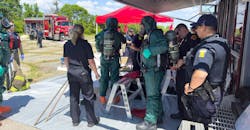Core Principles for Effective Communication During an Expanding Fire/Rescue Incident
Key Takeaways
- Fire department incident commanders must recognize the difference between internal and external communications and what the differences mean to the intended audiences.
- During an expanding incident to which a fire department responds, periodic Zoom calls can bridge communications gaps that might exist because of the involvement of numerous agencies.
- The familiarity that results when a fire department’s public information officer gives all interviews bolsters public confidence.
On May 20, 2024, because of safety concerns that were discovered during a fire inspection, the Toledo, OH, Fire and Rescue Department (TFRD) responded to a hazmat incident in a large commercial building in a residential neighborhood. The concerns included improper chemical storage and a nonoperational fire suppression system. The TFRD Hazardous Materials Team made numerous entries into the building for chemical identification. The response led to the issuing of a serious hazard order, which required the evacuation of the building for more than a week and periodic air quality monitoring. Fortunately, there were no injuries to civilians or first responders, and there never was an active threat to nearby residents and businesses.
As the incident commander, my three priorities were to develop hazmat operation objectives, establish unified command and maintain effective communication. It’s the effective core communication principles that are examined below.
Internal & external issues
Communication at an expanding incident should include both internal and external considerations. There’s an important distinction between the two when it comes to the sharing of information. Strategy and tactics that we utilized to mitigate the aforementioned incident included vernacular that sometimes isn’t decipherable to members of the media or the general public. Simply put, they don’t talk like we do. The message that’s shared with them is more of a general overview of the situation, the action that’s being taken to keep them safe and the duration of their potential inconvenience.
Communicating with one another in unified command and keeping the media and public informed were equally important to the successful outcome of the incident. These core principles can best be explained by separating them as internal and external communication strategies.
Internal strategies
Internal communication strategies involve shared intelligence, strategy and objectives among all responding agencies that are part of the unified command element.
The incident included the response of local, regional and federal organizations, which required coordinated communications among agencies.
There must be information flow to mitigate the incident safely and successfully. In regard to the noted hazmat incident, periodic Zoom calls were held to bridge any communication gaps because of the amount of agencies that was involved.
Sharing intelligence among unified command partners is vital for coordinated and effective incident response. When agencies and organizations that are involved in a unified command share real-time information, they gain a comprehensive understanding of the situation. This information-sharing enhances situational awareness and decision-making, which results in better management of the incident.
We found text messaging to be the most efficient way to share real-time information among unified command leadership, particularly those who weren’t working onsite. This messaging filled the gaps between briefings, to keep everyone informed on objective status and mission progress.
Such unified command collaboration helps to identify threats, allocate resources efficiently, and avoid duplication of efforts or conflicting actions. It also builds trust and ensures that all partners work from the same information, or sing off of the same song sheet, if you will.
Ultimately, this internal communication effectively strengthens the overall response, increases safety for responders and the public, and improves outcomes during expanding incidents.
External strategies
External communication strategies involve shared information that’s specific to the public and the media to keep them informed from the inception of an expanding incident to its conclusion.
It’s common during an expanding incident to develop a joint information center, or JIC, to coordinate all incident-related public information messages. Keeping the media informed during an expanding incident is essential to ensure that the public receives accurate and timely information. This can be accomplished through press releases and regular
scheduled interviews.
Social media as a communications vehicle should be a part of the multichannel communication strategy.
Inform the media and the public of the details of the incident early and often. The goal is to prevent the spread of rumors and misinformation. Things will start to unravel quickly if there isn’t public trust. Transparency in communication can be reassuring to the public and media and can help to maintain trust.
Another way of ensuring this trust is to provide timely updates. This is particularly important when there are pending evacuations or power outages because of the incident. Our department’s public information officer gives all of our interviews. The public got used to seeing and hearing from him, and familiarity during a crisis helps to bolster public confidence.
The importance of addressing public concerns quickly can’t be overstated. This feedback and active-listening process goes a long way to reaffirming confidence in the mission. Further, a contentious relationship with the media and/or the public can be an incident within an incident and distract from the emergency. An expanding incident is challenging enough; there’s no need to make it more difficult than it already is.
Communication is key
Effective or ineffective communication makes or breaks an incident. Give yourself every advantage possible by developing a crisis communication plan (CCP) in advance. We were fortunate when the hazmat incident that’s noted above occurred that we developed a CCP ahead of time that addressed the core principles on effective internal and external communication. A CCP is paramount to effectively communicate during expanding incidents. A well-developed plan outlines clear roles and responsibilities, which helps to reduce confusion in the midst of an incident. The CCP also keeps a lot of the guesswork out of things and allows the focus to stay on mitigating the incident and looking out for the health and safety of the community that you serve.
About the Author

John Kaminski
John Kaminski has 33 years in the fire service and is currently the assistant fire chief for the Toledo, OH, Fire and Rescue Department. He is a member of the FEMA USAR Red Incident Support Team and a task force leader with FEMA USAR Ohio Task Force 1. Kaminski has a master’s degree in emergency management/homeland security from Arizona State University and is an adjunct professor for Bowling Green State University’s Fire Administration program.
